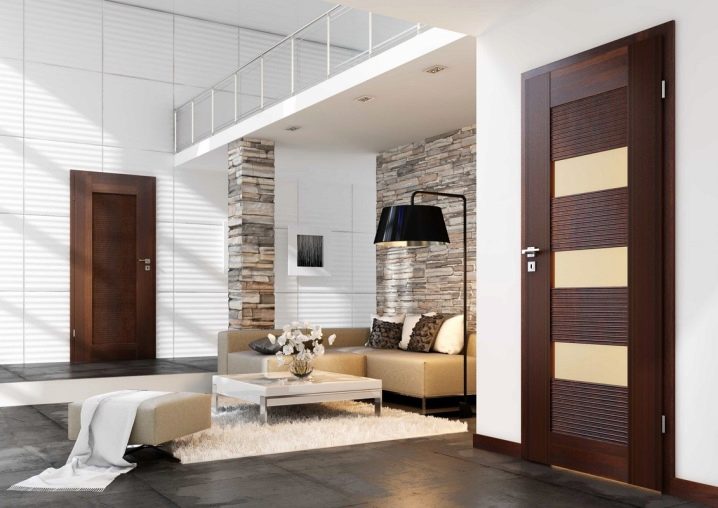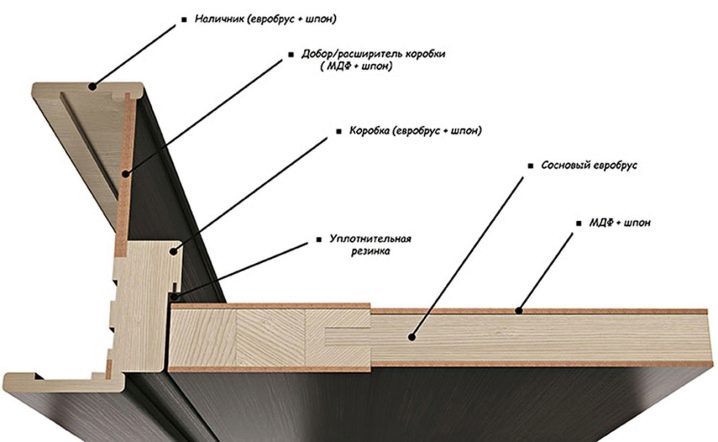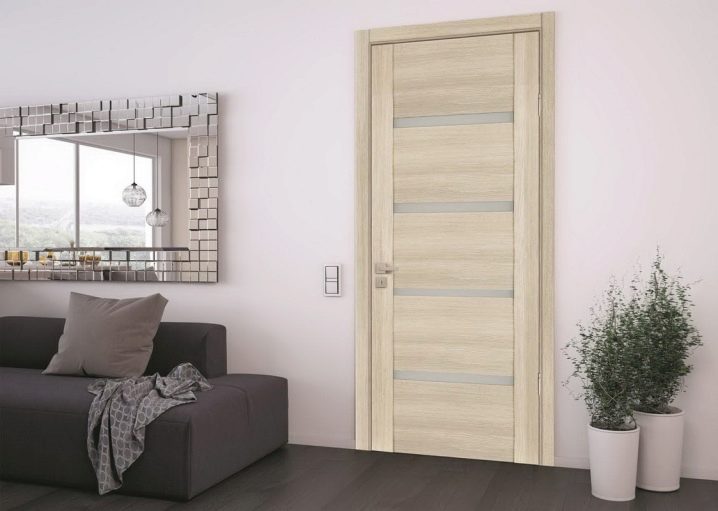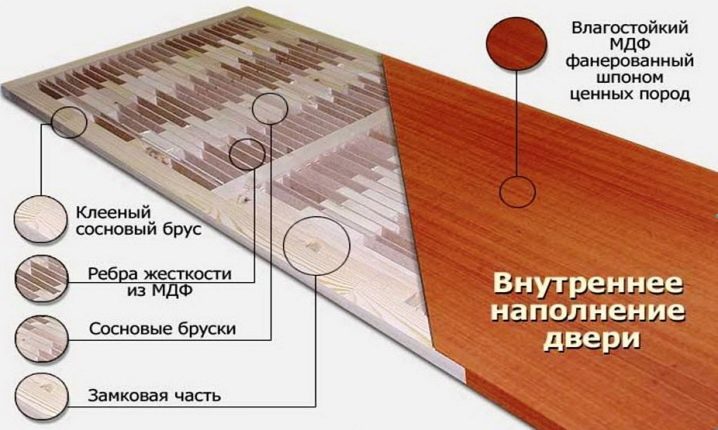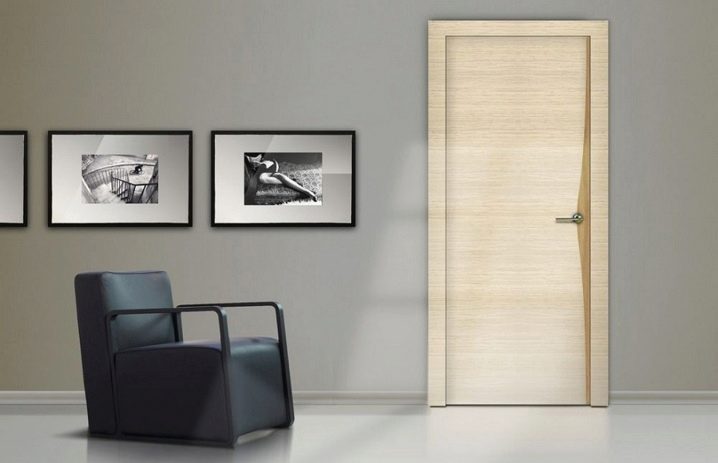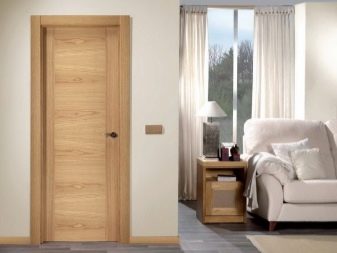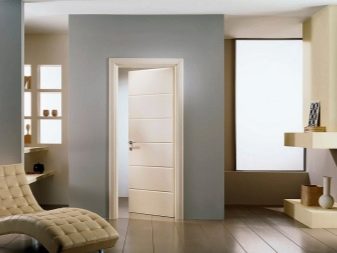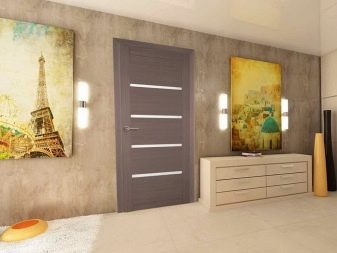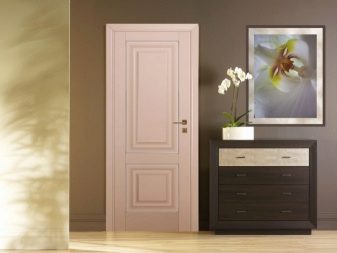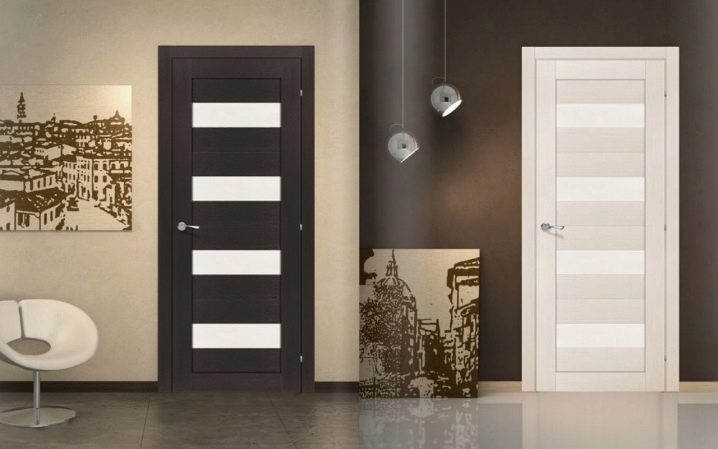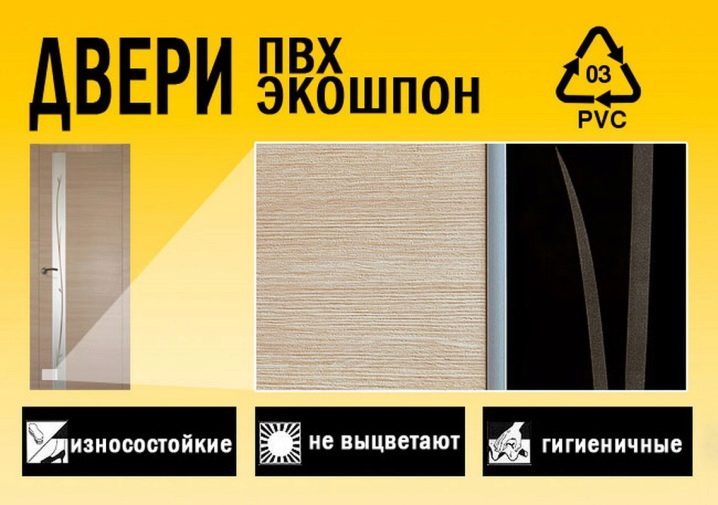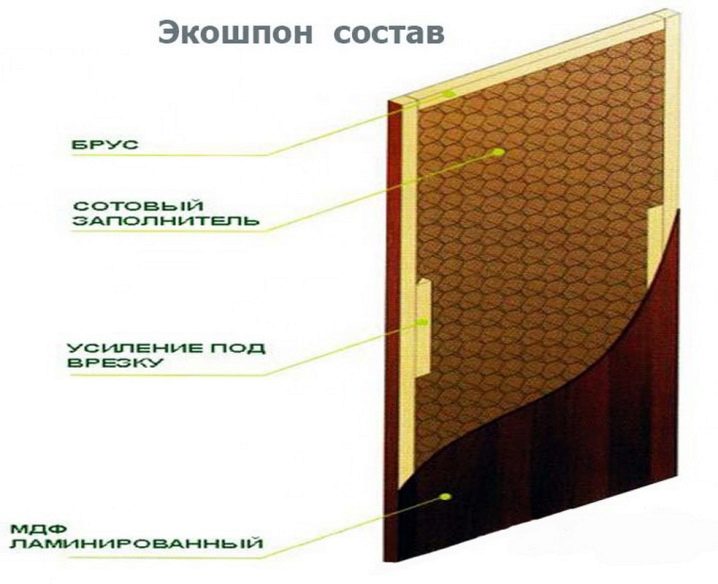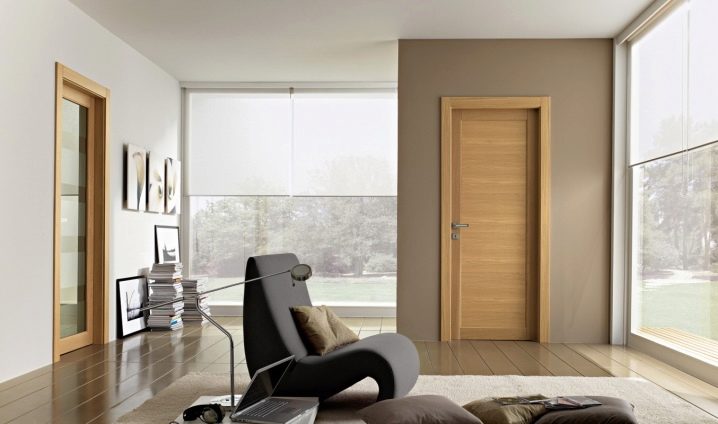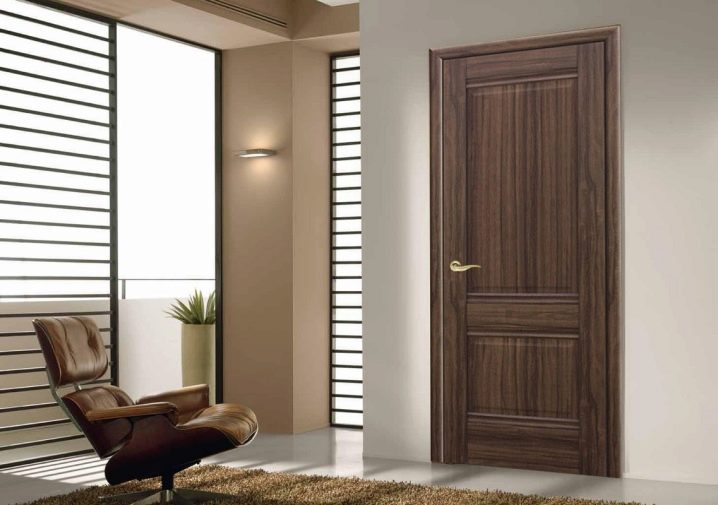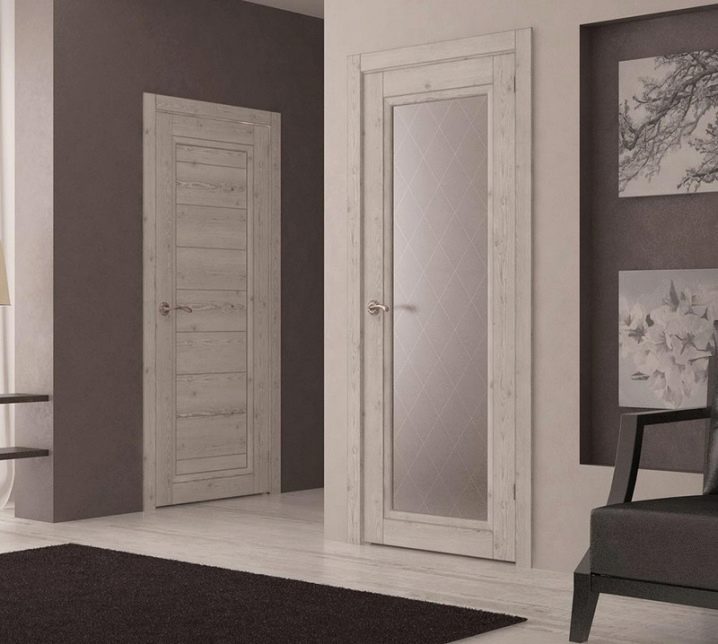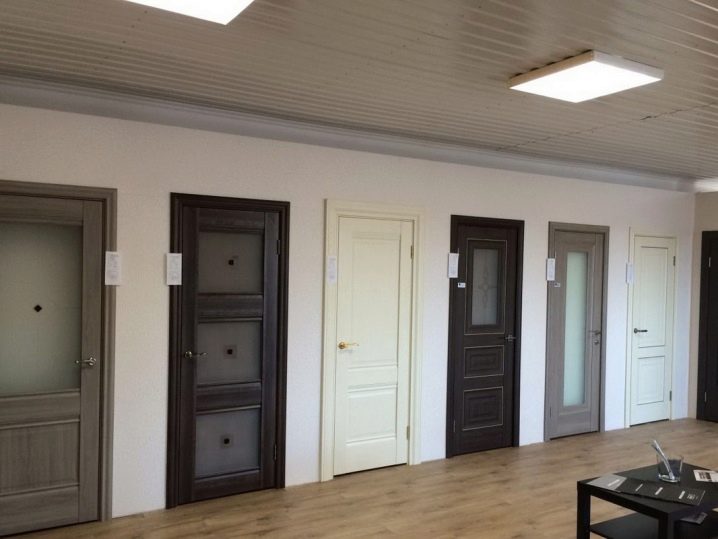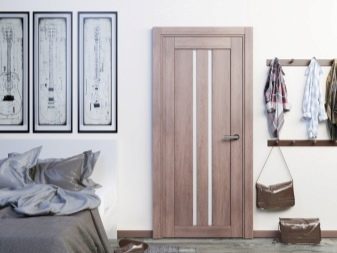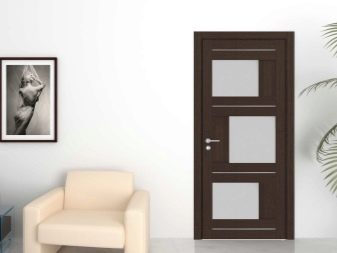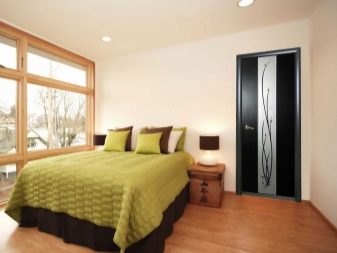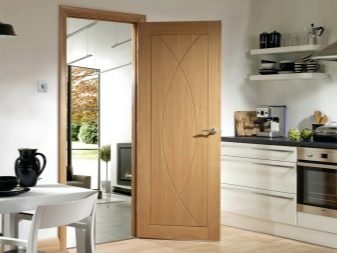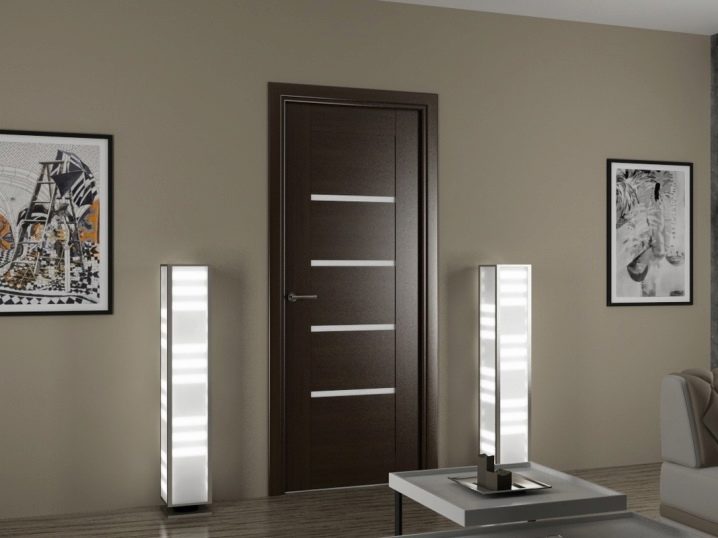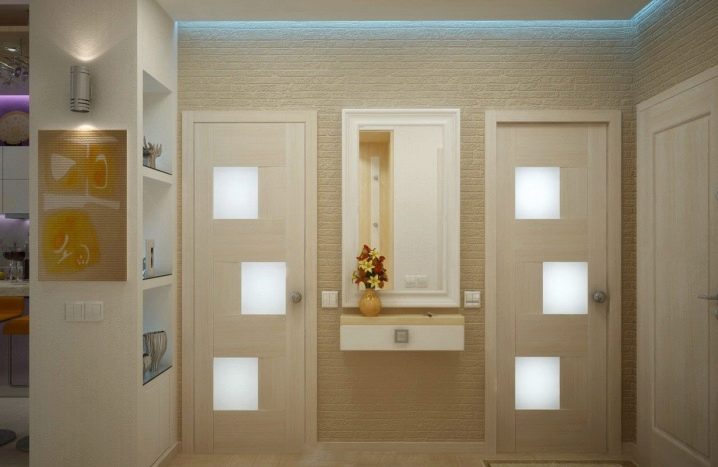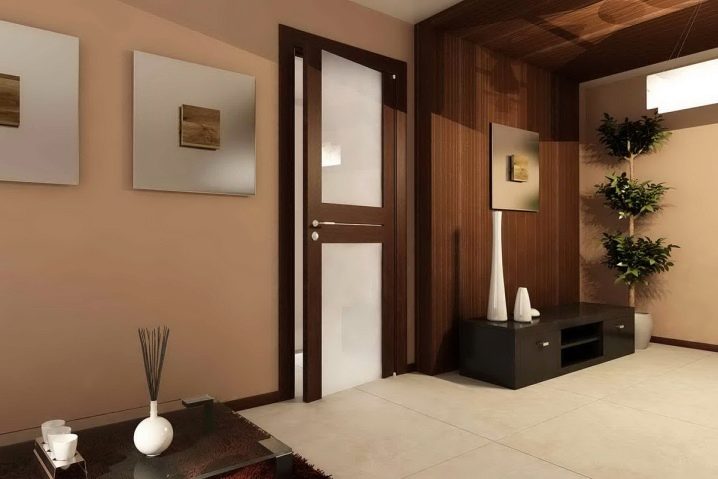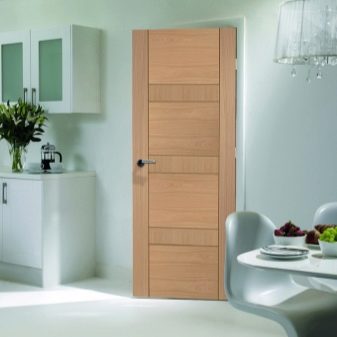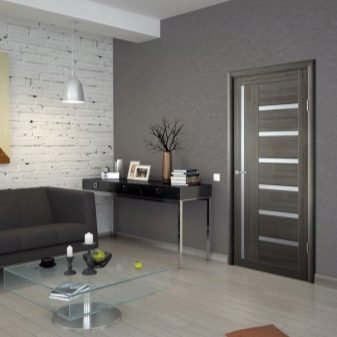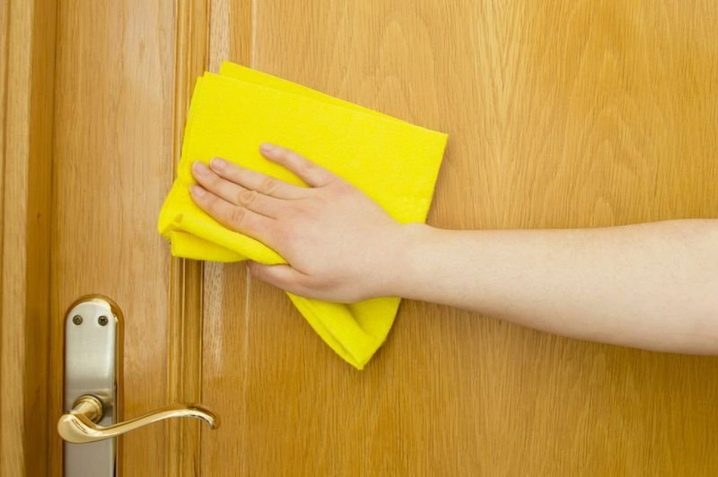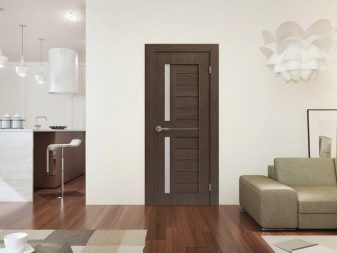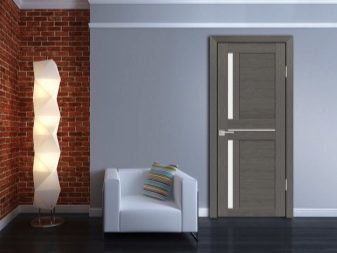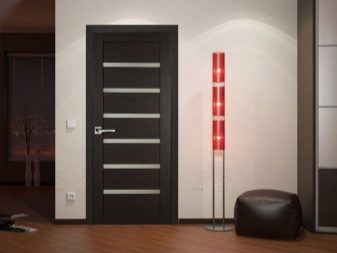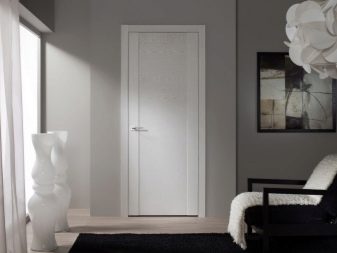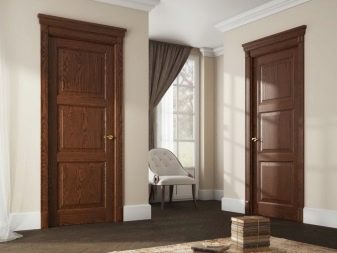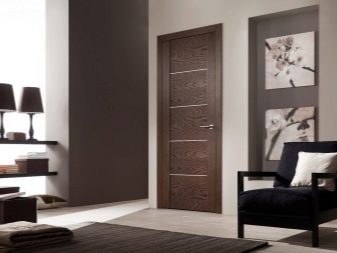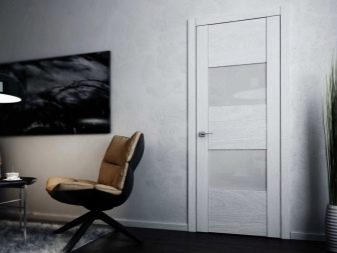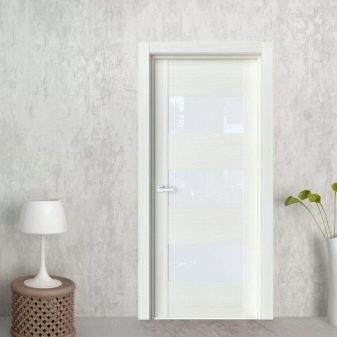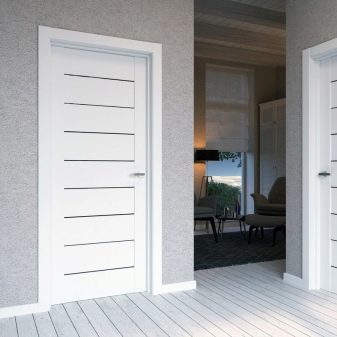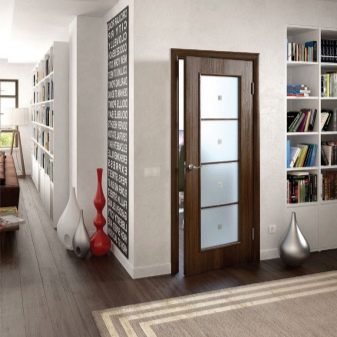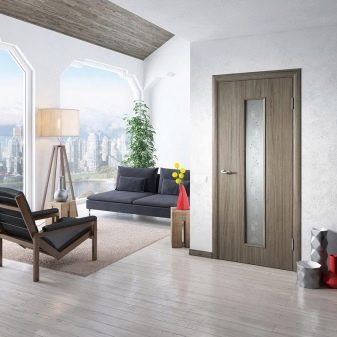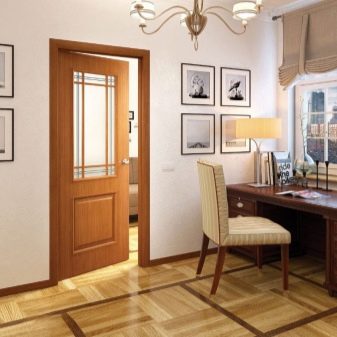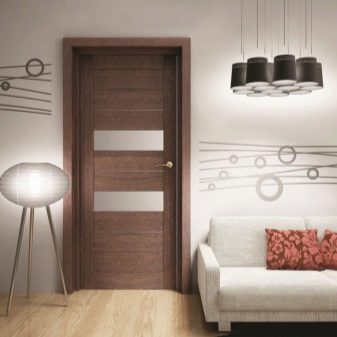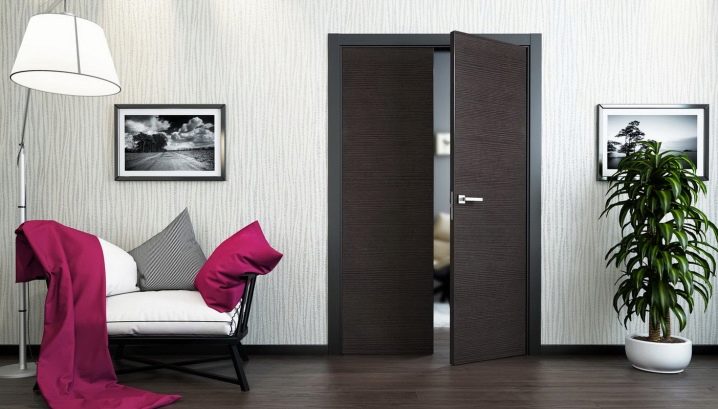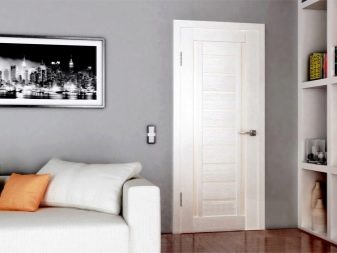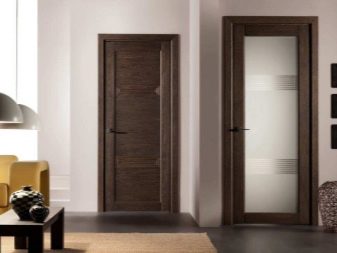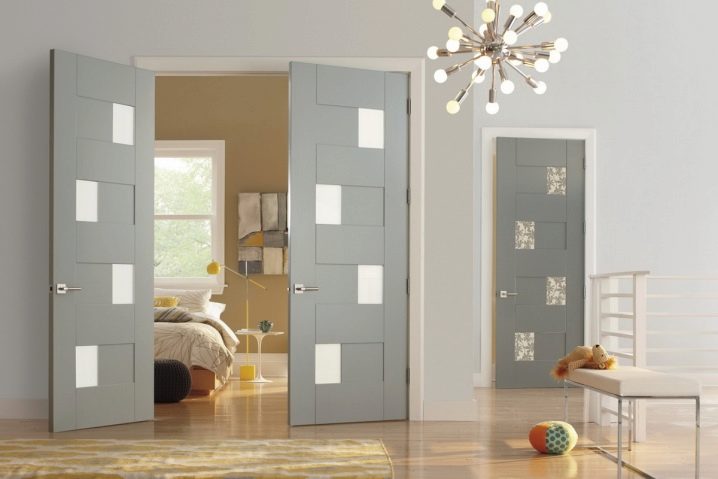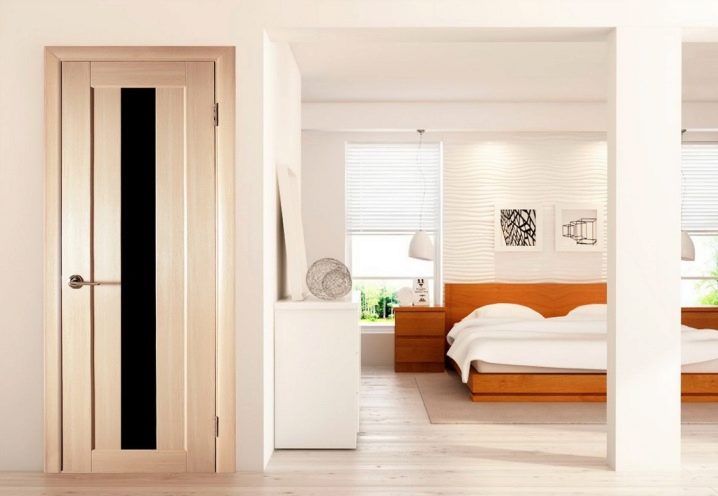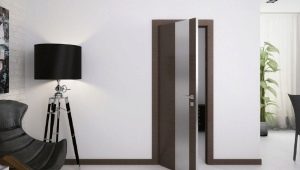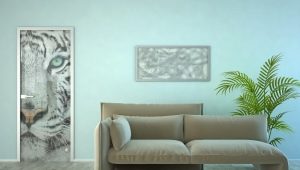Ekoshpon doors
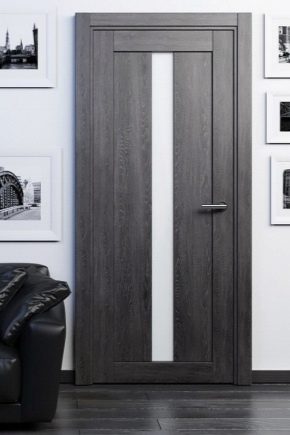
Buying interior doors is quite a costly undertaking, especially if the canvases are required for several rooms at once. If the allocated budget is not enough for the purchase of wooden products, then it's time to consider doors from an eco-pouch - a decent, high-quality and affordable counterpart. Doors with synthetic coating today choose even those families who could afford natural wood, because eco-shears have several advantages over a natural array.
What it is?
An eco tile is a top covering material for a door. It is often used for cladding furniture and stairs, and resembles a thin section of natural wood - veneer, but the name "eco" was due to the method of production. They produce eco-shears made of wood fiber and adhesive composition: sawdust is painted, mixed and glued together.It turns out uniform in thickness sheet with a rough texture on the type of one that has a natural wood. This is the main advantage of this material: it strongly resembles wood in appearance.
Doors made from eco-shells differ from natural cover, but such a distinction becomes visually more difficult or easier depending on the quality of the veneer itself. A good veneer is difficult to distinguish from a natural cut of a tree, even close: the pattern and texture strongly resemble wood, and only repetitive patterns on the canvas and the characteristic glossy shine can produce a synthetic origin. Doors covered with CPL-plastic or ekoshpon, are durable: they are resistant to temperature and humidity, scratches, light shock.
How do?
Doors from an eco-range differ in a design (deaf, with a panel or glass), design and cost. The device of almost any such model looks like this:
- A framework from a glued bar of natural wood - a fir-tree, a pine or other coniferous breed;
- Tsargi, or stoyovye for doors - lintels, plug-in elements;
- MDF plates that form the surface of the door;
- Ecointerline, directly attached to the wood board.
Eco-shears are produced on special presses based on woodworking industry waste - sawdust and shavings. The result of the press - sheet material, which is supplied to the door factories in rolls. The direct production of doors from an ekoshpon consists in cutting this material and applying it on the details of the future door: tsarga, MDF board. It is interesting that each external element of the canvas is wrapped in eco panels, and only after it is assembled into a single structure. This eliminates the risk of material peeling during use. and significantly prolongs the life of the canvas, preserves its aesthetic appearance.
Advantages and disadvantages
Cloths from an ekoshpon have a number of advantages thanks to which the buyer chooses on them:
- Affordable price. This is probably the most important criterion when choosing a door leaf. It is the low cost that is attractive to the future buyer: it is 2-3 times lower than the doors made of natural wood and 3-5 times - from 100% array cloths;
- High wear resistance. The synthetic material of the outer coating is scratch resistant,which can not be avoided during operation. Especially often eco-selection is chosen by families with pets and small children. The material is resistant not only to mechanical damage, but also a change in temperature and humidity in the room, which means it is ideal for a bathroom or a small kitchen;
- Reminds a natural tree. Eco-sheeter imitates the texture of natural wood, and an inexperienced buyer is unlikely to distinguish one from the other. An experienced person will notice that the pattern on the ekoshpon repeats, the color is uniform, which cannot be avoided in natural veneer. But modern technologies already allow to produce artificial veneer of non-uniform shade with artificial rings and differences in color;
- Low weight. Doors made from ekoshpon is much lighter than wooden canvases, because inside such a canvas lies a frame filled with honeycomb core. In fact, such doors are hollow inside, therefore light. There are models with a full-fledged solid pine inside, but they are also lighter than classic wood from 100% solid wood;
- Safe. In spite of the fact that the ecointerline interval is very different from the natural one, it is safe.There are no formaldehydes, chloride and other harmful impurities in it, which means that the cloth from the eco-pouch can be put in small apartments and children's bedrooms;
- Do not require care. Caring for an ekoshponom is reduced to wiping the fabric with a slightly damp cloth and does not require special cleaning agents;
- Long service life: about 5-10 years. It depends on the filling of the door (solid pine or glued frame and cardboard filler).
The disadvantages of such paintings are called:
- Insufficient noise insulation, because inside such doors are usually hollow or filled with cardboard, which transmits sounds well;
- Impossibility of restoration and repair in case of damage - the door will have to be replaced;
- Low weight, which can lead to deformation of the canvas with its constant blows against the wall during opening;
- Synthetic materials in the composition, which are not environmentally friendly. They do not allow the door to breathe and may not significantly affect the microclimate of the room.
Which is better?
Interior doors today differ in a variety of not only forms, but also finishing materials. Along with the ekoshpon, the doors are finished with PVC coating, there are laminated and painted enamelled models. We will understand what their differences are and which are better:
- PVC - polyvinyl chloride. Already from the name it is clear that this material contains a chloride component - safe within normal limits. PVC material is a film that is applied to the fabric by pressing and differs in a wide range of shades, in contrast to the same ekoshpon. Plus PVC doors and that they are cheaper than the rest. Inside they are almost always honeycomb filler made of cardboard, they are externally finished with MDF and covered with foil. Their service life is determined by 5-7 years.
Among the disadvantages of PVC coatings are the unpresentable appearance and short service life, the impossibility of restoration even with minor damage.
- Laminated doors - another affordable and attractive from the point of view of quality analogue of wooden linen. They are classified as economy class. The basis of this model is a frame made of lumber and honeycomb cardboard filler or a full-fledged solid pine, lined with MDF-plates. As the exterior is used laminate - a material based on synthetic resin, or film. It is durable and resistant to mechanical stress, temperature changes.Laminated doors can resemble natural veneer with a texture and woody pattern, or be smooth, glossy, bright.
They do not need special care and are not afraid of either moisture or direct sunlight, unlike PVC film, because it burns out in the sun.
- Doors with enamel - painted canvas, the main difference lies in the presentable appearance, uniform texture and coating.
- If we talk about natural wood - an array and veneer, then synthetic coating sometimes wins them in quality. It is moisture-resistant, which cannot be said about 100% wood: it can deform from high humidity or too dry air in the room. Depending on the operating conditions, these changes may not be visible to the eye. Of course, the array looks more aesthetic and more expensive than artificial turf, creates a favorable indoor climate. The difference between the artificial surface lies in the coating itself. Experts consider laminated doors to be the best choice in the economy class segment: they imitate natural veneer in texture and color, inside they usually are pine solid - durable material with excellent sound and thermal insulation qualities.
Attracts affordable cost of fabric and long service life.
Kinds
Door leaf of ekoshpon may be deaf or with glass. Deaf canvas - completely wooden without glass, metal or plastic inserts, but, possibly, with panels - horizontal and vertical wooden inserts.
The door with glass transforms the interior. The glass insert can occupy half or almost the whole door, it can be thin glossy strips or small elements.
Dimensions
The standard height of any door leaf is 2000 mm, or 200 cm. Standard width: 600, 700, 800 and 900 mm. If we talk about the thickness of the canvas, then it is usually 40 mm, but the doors of different manufacturers by 1-5 mm may differ from the generally accepted standard, and this is considered the norm.
Non-standard doors have a height of 2100, 2200 and 2300 mm, width - 400 mm and 1000 mm. They are 20-30% more expensive than standard canvases. Manufacturers rarely produce too high or wide doors of ekoshpon because of their low weight. To make such a canvas really long and pleasing to the eye, you need to choose a solid pine in its base instead of an “empty” frame.
Solid or spliced solid pine retains heat better and isolates noise, and such doors, even with a synthetic coating, can cost more than the same,but cheaper than natural veneer and especially solid oak or beech.
Colors
The eco pallets can have a woody shade and imitate natural wood: Italian walnut, light oak, wenge, ash, beech, mahogany, larch, or different from the usual and have a cappuccino shade, white, smoky gray, pearl, vanilla and others.
The main advantage of ekoshpon cloths - wide range of shades, thanks to which a unique image of a room is created and its classical or modern format is maintained. Brown shades win in the classic interior, white, gray and other unusual - in modern.
How to choose?
The main criteria for choosing an interior door are:
- Base material. At the heart of the quality door is a solid pine - full or spliced (that is, glued together the bars). At the heart of cheap doors is usually a hollow frame of wooden bars, filled with cardboard type of honeycomb;
- Dimensions of the canvas. The thicker the door, the better (if we talk about the ekoshponon). Such a canvas will not be too massive, but it can be extremely thin, but this will affect the sound and heat insulation;
- Finishing and color.Eco-sheeters usually imitate the texture of natural wood, and for a classic interior it is better to choose woody shades like oak, beech or walnut. The modern interior looks good coffee and gray scale, white and black;
- Noise isolation. Well isolate the door noise from solid pine inside and with an ekoshponom outside. This property is influenced by a dense abutment of the sheet when closing and the absence of gaps, gaps after installation;
- Resistant to moisture. The eco-sheath is resistant to temperature changes, humidity and even water ingress onto the canvas, therefore, doors with such a coating can not be afraid to put in the bathroom;
- Resistant to mechanical damage. The veneer is resistant to minor damage - scratches, but strong blows with a foot or hand, objects will not stand if the frame with a honeycomb core is inside.
Interroom doors from an eco-range differ in not only design, but also a design. At the heart of the most costly models is a wooden frame and cardboard filler, which are poorly insulated noise and unstable to strong shocks. If the door consists of solid pine, then it becomes more weight and resistance to accidental impacts.In short, a canvas with a solid array in the "stuffing" will last longer.
The choice is often influenced by the price of the canvas. Famous Russian factories often overestimate the cost of the door, but customer reviews prove that it is better to choose a proven brand than products of unknown origin.
Another important selection criterion is the interior style.. The doors differ in shape, which can be strictly rectangular or with smooth corners, with or without panels, with glass or metal inserts. In the classic interior, the deaf and glazed models with smooth corners look good, in the modern interior - with metal inserts and clear proportions, black glass and glossy white. Color of a cloth depends on tastes of buyers. Ash, oak, beech is a classic that looks equally good in a simple or modern interior.
Summarizing the information, we note that the doors of the eco-range are of higher quality, more practical than the natural coating and 2 times cheaper in cost. But when choosing them, you should definitely not skimp and choose frankly cheap canvases.
Let the models be not the cheapest and be in the middle price category, but they will serve for a long time and fulfill their functions 100%.
How to wash?
Doors from an ekoshpon do not demand special leaving.The cloth is simply wiped with a sponge moistened with water or with a special solution, then it is wiped dry so that there are no stains on it. You can prepare the product for the care of the canvas yourself: dilute the water with alcohol in the ratio of 9: 1. Moisture-resistant cloths with artificial finish do not require care with the use of special wax or resins that protect the coating from moisture. The only condition is a soft cloth without hard abrasive elements, which can scratch and ruin the canvas.
Manufacturers
The assortment of factories for the production of interior doors may not be canvases from 100% solid wood and even natural veneer. But there are always doors made of ekoshpon, and the reason for this is the high demand for them:
- Profilo Porte. The Russian manufacturer, the second name of which is Mariam, produces canvases from natural and eco-shells. Doors can be frame or sub-shaped with a honeycomb core filler.
- "Volkhovets" produces various types of doors: from solid wood, veneer and synthetic coating. The manufacturer does not speak about ekoshkpone, and pronounces the name Ciplex - the same ekoshpon, only in the format of innovative development of the brand.
- Estet. The Russian brand, which produces only doors from an ekoshpon, which they call NatureWood - “natural wood”. The coating repeats the texture of wood, but is much stronger than natural material, cheaper and easier to clean.
- Verda. In the classification of this brand there is a category Premium and Standard for eco-covering. Standard models are available in a classic design and 4 shades. Premium - in various styles and even sizes: from the standard height of 2000 mm to 1900 mm and 2050 mm.
There are hundreds of more and less well-known manufacturers of eco-facing ceiling ceilings. Famous manufacturers give their goods more expensive, use modern production methods and even unique technologies that are available only to them.
Eco-sheeter can be called whatever you like, but its essence is one thing - it is a synthetic coating that always imitates natural wood.
Options in the interior
Veneered doors look great in the interior, sometimes they are difficult to distinguish from natural wood. And vice versa such doors eagerly show their origin with a glossy shine and a perfect uniform coating:
- Color of wenge - color of natural valuable breed of wood.This door looks good against the background of contrasting white trim in a modern interior.
- Bleached oak in this finish is similar to natural: veneer is not uniform in design and texture and it seems that the canvas is made of solid oak.
- A great example is brown doors of a strict form in modern style. Modern white classic, which looks expensive and elegant, despite the artificial materials in the decoration of the canvas.
Reviews
The ekoshpone is so varied that it is impossible to say for sure whether it is good or bad as the material of the exterior finish of the door leaf. Those who are "in favor" of eco-spar note that such doors are inexpensive, but they look quite stylish and aesthetic in the interior. There is practically no hint of non-natural origin in high-quality eco-linen. Buyers say that it is advantageous to beat the artificial door helps the finish to match the door itself.
If the door is properly installed and has no gaps, then it does not allow noise and heat, even if there is a cardboard inside it.
Those who are against the ekoshpon and remained dissatisfied with the quality of such a door, note that it looks cheap and wears out quickly.The film quickly peels off the door, scratches and minor damage become very noticeable. Over time, the difference between an ekoshpon and a natural tree becomes obvious.
You will learn about the difference between doors with “eco-cover” and “eco-ceiling” doors, from the following video.
